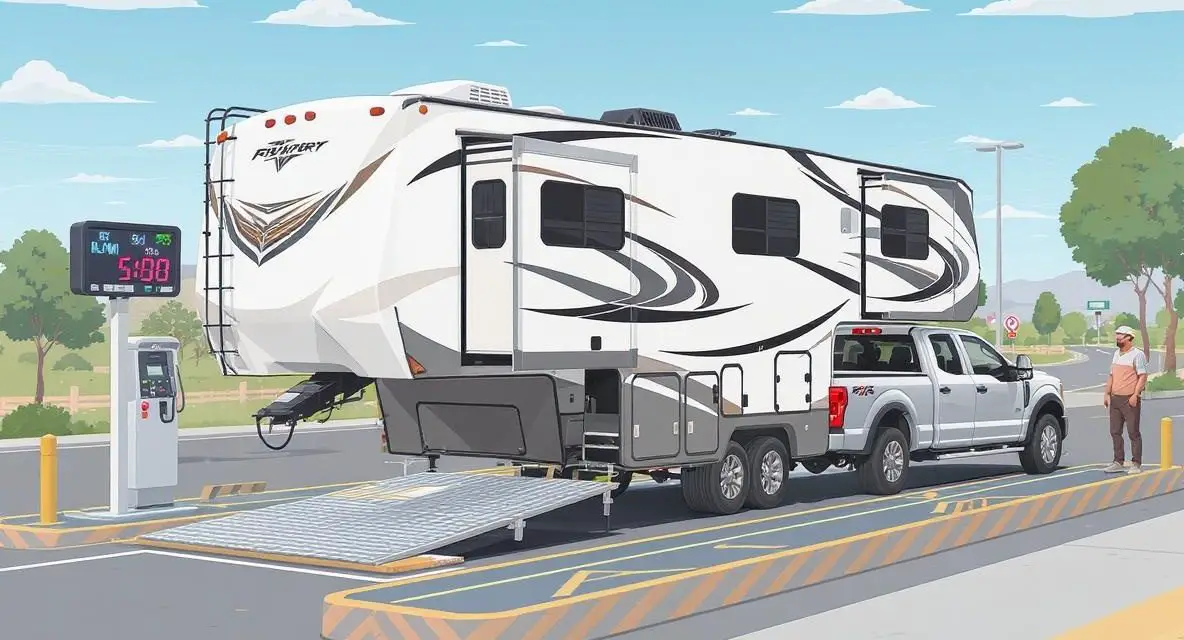Would you like to save this article?
You’re cruising down the highway with your home-on-wheels when suddenly—BOOM! A tire blowout sends you careening toward the shoulder, heart pounding and adrenaline rushing. What you didn’t know is that your RV was carrying more weight than it was designed to handle. This terrifying scenario happens to thousands of RVers every year, and it’s completely preventable.
The simple act of weighing your RV could save your life, your wallet, and your vacation. According to industry experts, a staggering percentage of RVs on the road are overweight, putting families at risk every single day.
Don’t become another statistic—let’s dive into the eye-opening world of RV weighing that every responsible RVer needs to understand.
1. Your RV is Probably Heavier Than You Think (And That’s Dangerous)
Most RVers live in blissful ignorance about their rig’s actual weight. You’ve loaded up your washer-dryer combo, that new memory foam mattress, your collection of camping chairs, and enough canned goods to survive a zombie apocalypse. But here’s the kicker: all those “little” additions add up faster than your credit card bill at Camping World.
The Hard Facts:
- According to weighing experts, approximately 55% of all fifth wheels are overweight when actually measured
- The average RV owner underestimates their rig’s weight by 1,500-2,000 pounds
- Overweight RVs are 3 times more likely to experience tire failures
- Weight distribution problems contribute to 75,000 RV-related injuries annually
Our take: It’s like that friend who claims they “only had a few drinks” but then tries to parallel park using the neighbor’s mailbox as a guide. RVers have a magical ability to convince themselves that their 47 storage bins of “essential” items somehow weigh nothing. Spoiler alert: physics doesn’t care about your optimism.
2. Understanding GVWR Could Save Your Life (It’s Not Just Alphabet Soup)
GVWR stands for Gross Vehicle Weight Rating, and it’s arguably the most important number on your RV that you’ve probably never paid attention to. Think of it as your RV’s weight limit—exceed it, and you’re playing Russian roulette with a 30,000-pound bullet.
What You Need to Know:
- GVWR = Maximum safe weight of your RV fully loaded
- GAWR = Gross Axle Weight Rating (per axle)
- Exceeding GVWR can void your insurance coverage in case of an accident
- Legal penalties for overweight commercial vehicles can reach $10,000+ in fines
| Weight Rating | What It Means | Why It Matters |
|---|---|---|
| GVWR | Total max weight | Safety & legality |
| GAWR | Max weight per axle | Tire & suspension limits |
| UVW | Empty weight | Starting point for calculations |
| CCC | Cargo carrying capacity | How much stuff you can add |
Our take: GVWR is like the speed limit of the RV world—everyone knows it exists, most people ignore it, and the consequences catch up with you when you least expect it. The difference is that speeding might get you a ticket, but exceeding GVWR might get you a hearse.
3. The Tire Blowout Epidemic is Real (And Preventable)
RV tire blowouts aren’t just inconvenient—they’re downright terrifying and surprisingly common. When you’re hauling thousands of pounds at highway speeds, a blown tire can turn your dream vacation into a nightmare faster than you can say “roadside assistance.”
Sobering Statistics:
- 76,000 RV accidents occur annually in the United States
- Tire-related incidents account for 40% of all RV breakdowns
- The average cost of a roadside RV tire blowout (including towing and repairs): $1,200-$2,500
- Overweight RVs experience tire failures 300% more often than properly loaded rigs
Signs Your RV Might Be Overweight:
- Excessive tire wear on the inside edges
- Springs appear flattened or have lost their arch
- RV feels unstable or bouncy while driving
- Decreased fuel economy
- Difficulty maintaining speed on hills
Reality check time: Watching a 10-ply RV tire explode at 70 mph is like witnessing a small bomb go off under your home. The rubber doesn’t just go flat—it disintegrates into shrapnel that can damage your RV, other vehicles, and potentially cause serious accidents. All because someone thought their collection of cast-iron cookware was “essential.”
4. Where to Weigh Your RV (It’s Easier Than You Think)
Finding a place to weigh your RV isn’t like searching for a unicorn—they’re actually everywhere once you know where to look. The key is knowing your options and choosing the right one for your needs.
Top Places to Weigh Your RV:
| Location Type | Pros | Cons | Average Cost |
|---|---|---|---|
| CAT Scales (Truck stops) | Available 24/7, certified accurate | $13 first weigh, $5 reweigh | $13-18 |
| State weigh stations | Often free when closed | Limited hours, not always accessible | Free |
| Grain elevators/Co-ops | Usually free, friendly service | Limited locations, seasonal hours | Free-$10 |
| Sand & gravel yards | Free, can get individual wheel weights | May require permission, dirty | Free |
| RV rallies/shows | Professional service, detailed analysis | Limited availability, higher cost | $25-50 |
Pro tip from your friendly neighborhood RV journalist: CAT Scales are the gold standard of RV weighing. With over 1,900 locations nationwide, they’re more common than Starbucks and infinitely more useful for RVers. Plus, their “Weigh My Truck” app makes finding locations easier than finding excuses to buy more RV gadgets.
5. The Weighing Process Revealed (Step-by-Step Reality Check)
Weighing your RV isn’t rocket science, but there’s definitely a right way and several wrong ways to do it. Follow this process, and you’ll get accurate results that could literally save your life.
The Proper RV Weighing Sequence:
- Load your RV exactly as you travel (full tanks, all gear, passengers, pets)
- Drive onto the scale with just the RV axles on the platform
- Record the axle weight and compare to GAWR
- Pull forward until the entire rig is on the scale
- Record the gross weight and compare to GVWR
- Calculate your remaining capacity
What the Numbers Tell You:
- Under GVWR by 500+ lbs: You’re golden, maybe add that extra camp chair
- Within 200 lbs of GVWR: Time to reevaluate your “essentials”
- Over GVWR: Stop immediately and start making hard choices
- Uneven axle loading: Redistribute weight front to back
Here’s where it gets interesting: The weighing process is like stepping on a bathroom scale after Thanksgiving dinner—you might not like what you see, but at least you’ll know the truth. The RV in our featured video was pleasantly surprised to be under weight, but don’t count on being that lucky.
6. The Hidden Costs of Being Overweight (Beyond Just Tire Replacement)
Being overweight in your RV doesn’t just risk tire blowouts—it’s like a domino effect of expensive problems waiting to knock down your budget. Let’s talk about the real costs that RV manufacturers don’t put in their brochures.
The Financial Reality of Overweight RVs:
| Problem | Average Cost | Frequency |
|---|---|---|
| Premature tire replacement | $800-2,000 | Every 2-3 years vs 5-7 years |
| Suspension damage | $1,500-4,000 | 40% more likely |
| Brake system failure | $800-2,500 | 2x more common |
| Frame stress/cracking | $3,000-15,000 | Rare but catastrophic |
| Insurance claim denial | Potentially unlimited | If overweight causes accident |
Additional Hidden Costs:
- Increased fuel consumption: 10-20% higher when overweight
- Accelerated wear on tow vehicle: transmission, brakes, engine
- Higher insurance premiums: if you’re caught operating overweight
- Legal fines: varies by state, can exceed $5,000
Our take: Being overweight in your RV is like using a credit card to pay your credit card bill—it might work short-term, but eventually, the interest (in this case, repair bills) will crush you. The $13 you spend on weighing could save you thousands in the long run.
7. Most RVers Skip This Critical Step (Don’t Be One of Them)
Here’s the shocking truth: despite all the evidence, most RVers never weigh their rigs. Ever. They buy a $100,000+ home on wheels and never verify it’s safe to drive. It’s like buying a house without checking if the foundation can support it.
Why RVers Avoid Weighing:
- “It’s too complicated” (It’s not—takes 10 minutes)
- “I know I’m not overweight” (55% are wrong about this)
- “I’ll do it later” (Later never comes)
- “It costs too much” ($13 vs. thousands in repairs)
- “I don’t know where to go” (CAT Scales are everywhere)
The Weighing Schedule You Should Follow:
- Before your first trip with a new RV
- After major modifications (solar panels, generators, etc.)
- At least once per year during heavy use
- Before long trips when fully loaded
- Anytime you question your weight
When to Weigh During RV Ownership:
| Timing | Reason | Priority Level |
|---|---|---|
| Immediately after purchase | Verify manufacturer specs | CRITICAL |
| After adding major accessories | Ensure still within limits | HIGH |
| Start of camping season | Annual safety check | MEDIUM |
| Before cross-country trips | Peace of mind | HIGH |
| After loading for specific trips | Verify current load | MEDIUM |
Final reality check: Skipping the weigh station is like skipping your annual physical—you might feel fine now, but problems have a way of showing up at the worst possible time. The difference is that an overweight RV can hurt more than just you.
Conclusion: Knowledge is Power (And Safety)
Weighing your RV isn’t just a good idea—it’s an essential part of responsible RV ownership. As we learned from Mike and Jennifer’s experience in the video, the peace of mind that comes from knowing your exact weight is invaluable. They discovered they had plenty of capacity left, which meant they could travel confidently and even add more gear if needed.
The process is simpler than you think, cheaper than you fear, and more important than you realize. With over 76,000 RV accidents happening annually and a significant percentage linked to weight-related issues, can you afford NOT to know your RV’s weight?
Take action today: locate your nearest CAT Scale, load up your RV as you normally travel, and go get weighed. Your tires, your wallet, and your family will thank you.
SOURCES
- RV Lifestyle YouTube Channel – “An RV MUST DO!! Weighing your RV”
- Georgia Auto Law – RV Accidents Due to Weight Issues
- Fifth Wheel Street – RV Weighing Statistics
- CAT Scale Company – Scale Locator
- RV LIFE Magazine – Tire Blowout Prevention
- The RV Geeks – Common RV Accidents
- Mortons on the Move – RV Accident Causes
- RV.com – Understanding RV Weight Ratings






